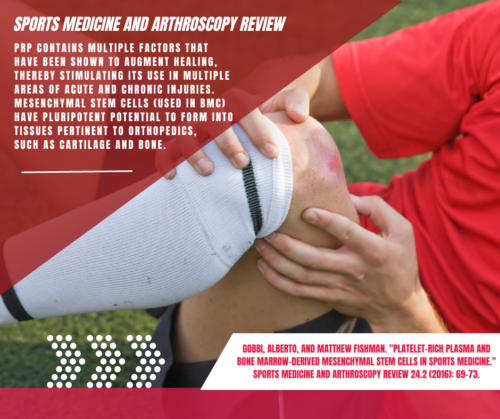 Regenerative Orthopedics, such as Bone Marrow Concentrate (BMC) and Platelet Rich Plasma (PRP) are growing in popularity in sports medicine and other fields of medicine. That’s because PRP has been shown to boost healing in many types of injuries, and BMC is said to repair tissue like cartilage and bone.
Regenerative Orthopedics, such as Bone Marrow Concentrate (BMC) and Platelet Rich Plasma (PRP) are growing in popularity in sports medicine and other fields of medicine. That’s because PRP has been shown to boost healing in many types of injuries, and BMC is said to repair tissue like cartilage and bone.
PRP is a concentration of platelets from a person’s own blood. The treatment uses the patient’s blood cells to accelerate healing in a specific area. Platelets contain growth factors that enhance the healing of soft tissue. When these platelets are concentrated, the healing potential is increased.
BMC is an aspiration of mesenchymal stem cells from bone marrow commonly taken from the iliac crest and then concentrated. These stem cells have the ability to differentiate into cartilage and bone. BMC has the potential to heal injured and arthritic joints.
Platelet Rich Plasma provides a healing environment or “scaffold” to build on, enhances stem cell proliferation, and basically tells the stem cells what to do. In a 2012 study, doctors at the Shanghai Jiaotong University School of Medicine say that “PRP is a candidate bioactive scaffold capable of releasing endogenous growth factors and that bone marrow stem cells and adipose derived stem cells seeded within the PRP scaffold were able to change into chondrocytes (cartilage building blocks) suitable for cell-based cartilage repair.”(1)
There is quite a lot of research showing the effectiveness of both PRP and BMC in repairing joint injuries and arthritis. The following are just some of the medical journal research results:
The Journal of Pain Research looked at 115 patients treated with BMC for arthritis and/or rotator cuff tears. What were the results? Both disability and pain decreased, and the improvement continued for up to 2 years.(2)
Another study looking at BMC’s effectiveness on rotator cuff tears compared to exercise also resulted in an improvement in function, a decrease in pain, and healing of the tendon. The findings suggested that BMC may be a safe and useful alternative to conservative treatments like exercise for managing rotator cuff tears. (3)
A study by Gobbi and associates on BMC for chondral defects of the knee showed significant improvement. (4) In another study, Gobbi also showed improvement in patellofemoral lesions of the knee with BMC. (5)
Can BMC help arthritis? Several human studies suggest a potential role of BMC in treating knee osteoarthritis evidenced by significant improvements in multiple clinical scores and increased cartilage healing. (6)
In the medical journal, Arthroscopy: The Journal of Arthroscopic & Related Surgery, researchers concluded, “Patients undergoing treatment for knee osteoarthritis with PRP or BMC can be expected to experience improved clinical outcomes when compared with patients who receive hyaluronic acid.” (7)
As you can see, PRP and BMC are effective in the treatment of various joint injuries as well as arthritis. These Regenerative Orthopedic procedures are great non-surgical alternatives for those with persistent joint pain, joint injury, and even arthritis.
At OrthoRegen, we have years of experience treating patients with PRP and BMC. If you are looking for a non-surgical option for your joint pain or arthritis, please call us at 310-453-1234.